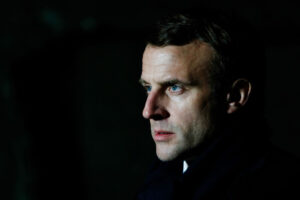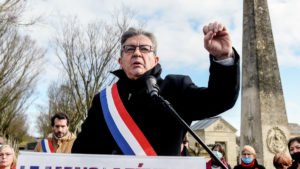Interviewed on French television last Friday, a prominent parliamentarian from the far-Left La France Insoumise, Matilde Panot, defended a claim made by her leader, Jean-Luc Mélenchon, about the relative inexperience of Léon Blum when he became head of the French government in 1936. When she was reminded that Blum had sat in parliament for over 15 years as leader of the French Section of the Workers International (SFIO), she conceded defeat. “I don’t know where I got that from,” she muttered.
Similar confusion hangs over the New Popular Front. The party is a surprise development of Emmanuel Macron’s decision to call a snap election. Its name invokes the union of the Left in the Thirties, which culminated in the Popular Front government formed in 1936: a government led by Léon Blum and a host of ministers from the SFIO and the Radical Party, and supported from the outside by the Parti Communiste Français (PCF) of Maurice Thorez.
Yet as Panot demonstrated, the choice of the name does not come from an intimate acquaintance with the history of the Popular Front. Today, it is little more than a slogan, one that celebrates a surprisingly quick display of unity on the Left and — above all — a desire to impress upon French voters the danger of a radical Right victory in the forthcoming elections. Indeed, if we compare more closely the world of 1936 with that of 2024, we can see how the New Popular Front is a very different beast from its namesake: rather than echoing the changing interests of particular social groups in France, it is an expression of electoral opportunism.
As the historian Claire Andrieu recently observed, the Popular Front of 1936 was a fusion of the socialist and communist movements in France, forced upon reluctant party and parliamentary leaders by party members and activists determined both to block France’s drift into authoritarian nationalism and to secure specific gains in the class war between workers and bosses. This move was triggered by violent demonstrations led by the far-Right Action Française group on 6 February 1934, which many viewed as an attempt to seize power. For months, leaders of both the PCF and the SFIO resisted these bottom-up demands for unity, until the PCF was told by Moscow to strike a deal with the socialists.
This fusion, and the elaboration of a shared legislative programme, was made more difficult by the nature of French democracy at the time. Though still excluding women, the Third Republic had become deeply embedded in society. Its political arena was populated not just by political parties but also a host of organised labour groups, and a plethora of committees and leagues of intellectuals. As a result, the Popular Front’s programme was signed off not only by the PCF, SFIO and Radicals, but also by the country’s principal trade unions. Thus the coalition was one of the first expressions of what the sociologist Peter Wagner called the era of “organised modernity”: collective action, pursued by social groups, structuring the lives of individuals, of families, of villages and towns, resulting in a fusion between politics and society.
By contrast, the New Popular Front of 2024 was negotiated in six days, behind closed doors, by party bosses. The agreement was struck between the Socialist Party, the Greens, La France Insoumise (LFI) and the French Communist Party. It also brought on board prominent figures who enjoy a more distanced relationship to the main parties on the Left: Raphaël Glucksmann, whose “Wake Up Europe” campaign for the Socialist Party did surprisingly well in the European elections, and François Ruffin, a firebrand who sits loosely on the LFI benches but functions more often as an independent voice on the Left.
Most obviously, their alleged catalyst is the prospect of a victory for the far-Right in the legislative elections. Macron’s decision to dissolve the national assembly came as a surprise for most and reflected a willingness to gamble with what he thought was still a refusal, among a majority of French voters, to accept that Marine Le Pen’s National Rally (RN) could ever become the party of government. Aware that this historic refusal may no longer exist, the disparate forces of the Left decided to put to one side their differences. This “antifascist” animation, however, is far from the only reason for this new alliance’s genesis — and perhaps not even the most important one.
Far more essential to the formation of the New Popular Front has been the electoral dissolution of Macronism as a political force. Evident already in the 2022 legislative elections, where Macron’s party was unable to win an outright majority in the national assembly, it was confirmed in dramatic fashion by the poor showing of the presidential party in the European elections of June 2024. In those elections, the combined score of the Socialists, Greens and LFI would have placed the Left within just five points of the RN, and a good 10 points ahead of Macron’s party. Thus, what brought these political figures together — who, just days before in the run-up to European elections, had been viciously accusing each other of antisemitism and warmongering — was the whiff of political office. Should the unified Left come ahead of Macron’s party in the first round on Sunday, they will most likely face the far-Right in a second-round run-off. And under those circumstances, they fancy their chances.
Paradoxically, however, as well as being its animating force, the implosion of Macronism is also the New Popular Front’s main limitation as a political force. It is, after all, operating only at the level of the political players themselves. There is no associated social movement or a coming together of rival social forces. Its programme is an amalgam of the interest of the different parties involved, with an economic programme that focuses on tackling the cost-of-living crisis.
This old Keynesian strategy of boosting aggregate demand through government spending has echoes of Mitterrand’s socialist programme of 1981. However, without a firm anchoring in French society, it is likely these measures would be just as short-lived as Mitterrand’s, who undertook a dramatic U-turn two years into his first term as President. Elsewhere, the New Popular Front has said it would reject the EU’s fiscal rules without explaining how it would go about doing this. Once again, there is a striking contrast with the original Popular Front, whose legislative achievements included the 40-hour week, two weeks’ paid holiday and a host of new additions to the French labour code which were sealed in the Matignon Agreement of June 1936.
Offering little by comparison, the New Popular Front is no more and no less than a product of the collapse in the centre. For this reason, it is not surprising to see the return of some of the familiar faces of the Left from the Nineties and early 2000s, such as the former socialist prime minister Lionel Jospin. Far from being a radical force for change, then, it reflects a belief among the old guard that this is a good time to impose a more moderate Left onto what had become a Mélenchon-dominated Left. Indeed, it seems fitting that the New Popular Front may well be a vehicle for the political return of the last Socialist president, François Hollande, who is standing in his old constituency in Corrèze, in the heart of France.
Crucially, because it is a product of the implosion of Macronism, the New Popular Front contains within it the seeds of its own demise. Little more than a product of a void, it is already coming apart as the rival figures within it make the case for why they are the best candidate for prime minister. Mélenchon has refused to step aside, declaring instead that he is ready to govern, invoking the ire of all other parties in the New Popular Front who have spent years criticising his rhetorical excesses and narcissism. The recent exchange between Hollande and Mélenchon, where each has said that the other should “shut up”, speaks volumes about the mood within the coalition.
Its essence, in other words, is far removed from that of 1936, when the Popular Front was the political expression of a vast social movement rooted in the struggle of the workplace: pay, working conditions and the right to collective organisation. Back then, it was overwhelmingly a workers’ movement, one that generated new forms of popular culture preserved in the joyful and sun-kissed photography of Pierre Jamet and many others. The New Popular Front of 2024, by contrast, is an alliance of political rivals occurring within a context of widespread cultural pessimism. Electoral success may yet lend it some impetus, but even then, it is difficult to see how it can escape the fragmentary pressures that produced it in the first place.
Disclaimer
Some of the posts we share are controversial and we do not necessarily agree with them in the whole extend. Sometimes we agree with the content or part of it but we do not agree with the narration or language. Nevertheless we find them somehow interesting, valuable and/or informative or we share them, because we strongly believe in freedom of speech, free press and journalism. We strongly encourage you to have a critical approach to all the content, do your own research and analysis to build your own opinion.
We would be glad to have your feedback.
Source: UnHerd Read the original article here: https://unherd.com/




